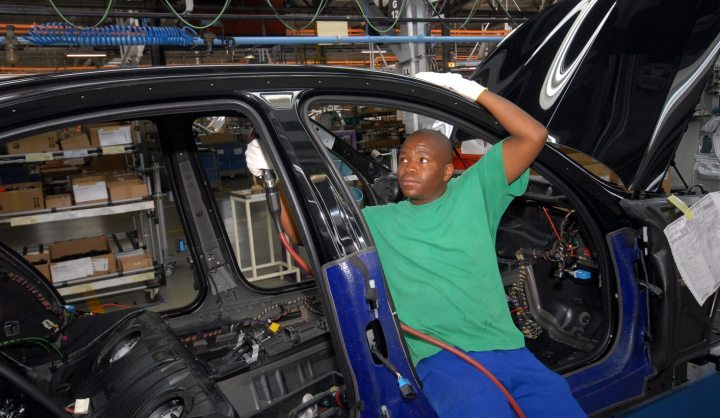South Africa
Op-Ed: National minimum wage will never hurt workers

The contempt for evidence-based research in a recent article by Free Market Foundation Director Eustace Davie – National minimum wage will hurt workers – is staggering. The polemic distorts (or ignores) the evidence, indulges in alarmist exaggeration and latches on to one unsubstantiated claim – that a national minimum wage will kill jobs and hurt the unemployed – and repeats, repeats, repeats. By GILAD ISSACS.
In a recent article titled National Minimum wage will hurt workers, Free Market Foundation Director Eustace Davie disputes the evidence on the relationship between minimum wages and employment advanced by myself, the co-ordinator of Wits University’s National Minimum Wage Research Initiative (NMW-RI). He goes on to offer a poorly informed and baseless attack on the statistical modelling undertaken by the NMW-RI. All the while he adopts the now-tired posture of the Free Market Foundation as the protector of the “’country’s forgotten people’ – the unemployed – against the wily ways of the labour aristocracy and their ‘academic soothsayers”.
A national minimum wage
The South African government, ruling party, and social partners at Nedlac have committed to the institution of one national minimum wage – a wage floor below which no worker can earn – as a complement to sectorally set minima (the system we currently have). Davie notes: “There are few countries in the world that have no minimum wage, but fortunately for the poor, most countries do not make it universal.” This is false.
Roughly 50% of countries with minimum wage regimes have a national minimum wage. According to the International Labour Organisation 61% of these national minimum wages are universal, without any exemptions and exclusions. This was the strong recommendation pushed by ILO and other international experts at the recent national minimum wage symposium hosted at Wits University.
National minimum wages are preferred to sectorally or regionally differentiated systems because they are easier to enforce, ensure coverage of all workers, can be set to take account of workers’ basic needs and aggregate economic impacts, and do not discriminate against vulnerable groups such as women and youth (as sectoral minima have been shown to do).
The evidence of the impact on employment
Minimum wages are advanced as a means through which to meet workers’ basic needs, alleviate poverty and tackle inequality; other policy instruments are required to stimulate employment. Nevertheless, a wealth of evidence, including from the International Monetary Fund and Organisation for Economic Co-operation and Development, shows that higher wages and reduced inequality are growth enhancing. International evidence on balance shows clearly that minimum wages play a critical role in reducing inequality.
Davie is correct when he quotes me as saying that the international evidence indicates that the impact of minimum wages on employment has been shown to be “slight, negligible or statistically insignificant”.
“Statistically insignificant”, a standard scientific concept, means that the relationship detected – between changing wage levels and employment – was too weak to be considered meaningful. Davie (wilfully I hope) misrepresents this when he characterises me as implying that “the people who lose their jobs will be insignificant – not worth worrying about!”.
Davie persistently claims catastrophic job losses will follow the institution of a national minimum wage. In doing so he cites only one study focusing on the negative impact of minimum wages on youth, teens and low-skilled workers in Canada, conducted by the ultra free-market libertarian think tank the Fraser Institute. This study is not representative of the international evidence nor is the Canadian labour market particularly instructive for the South African case.
There is no doubt that the impact of minimum wages on employment is differentiated by sector, firm type, worker demographics, region and so on. But there is also international consensus that the aggregate impact, if it exists at all, is slight. Developed country meta-analyses – studies which combine hundreds of individual studies by leading scholars such as Doucouliagos and Stanley (2008), Belman and Wolfson (2014) and Leonard et al. (2014) – all concur on this point. Doucouliagos and Stanley note: if there is an employment impact it “must be of a small and policy-irrelevant magnitude”. Indeed, these studies show that, where present, a 10% increase in minimum wages has, on average, a negative impact on employment of between 0% and 0.6%.
Alan Manning, leading UK minimum wage expert and professor of economics at the London School of Economics, concurred with this finding in his recent presentation at Wits.
Evidence from the developing world is less comprehensive. A World Bank paper argues that the impact of minimum wages on employment “may be positive in some cases” but is most often “insignificant or modestly negative”. The DPRU at UCT notes that “where negative effects are found they are usually small”. The neutral impact was highlighted in presentations at the Wits symposium by Latin American expert Professor Roxana Maurizio and Dr Lotta Takala-Greenish.
The overwhelming majority of these studies focus on specific groups or sectors and so may miss the positive macroeconomic benefits, including employment growth, of higher wages.
Why the “counter-intuitive” finding? First, wage costs are not the sole, or predominant, determinant of investment. More important for investment, experts argue, are: institutions; industrial clusters; state policy and technology; management techniques and good labour relations; social, physical and digital infrastructure; access to capital; workforce skills, and local and geographical advantages.
Second, companies adjust to higher wages in a range of ways, including: curtailing profit margins, reducing very high pay for top earners, efficiency gains, and changes in hours worked. Workers are also impacted on, including through greater motivation and staff retention, and shifting employment between sectors. Finally, the macro-economy stands to benefit with higher wages potentially fuelling consumption, output and growth.
Modelling the impact
This potential “virtuous cycle” is found to occur in the economic modelling undertaken by Wits’ NMW-RI. Economic modelling is not perfect prediction, but it is far from the “diabolical game” described by Davie. The model used by the NMW-RI (unlike certain other models such as that used by National Treasury) allows for the real-world adjustments described above to occur, and does a good job at capturing the dynamics of the SA economy.
Of course, as Davie quotes, the modelling entails various “scenarios” each with a different NMW level – all measured against a “business-as-usual” scenario in which the economy is left to proceed along its current path. If Davie had bothered to look he would have found the detailed estimated consequences of these scenarios available on the NMW-RI website. Over a 10-year period, after instituting an NMW: wages increase above inflation; household income rises by up to 50%; consumption could double; the GDP average annual growth rate expands, and poverty and equality fall, all compared with the “business-as-usual” scenario. Such consumption linkages and expansion of inter-firm demand due to rising wages has been well documented. Of course, the consequences vary according to the level at which the NMW is set.
As we reach our upper-bound NMW of R6,000, various economic indicators do become more unstable, indicating a “threshold” for a viable NMW (somewhere above the starting point for our third scenario, an amount of R4,623). The projected average annual unemployment rate, narrowly defined, would be 25.2% without an NMW (a truer reflection of unemployment would be the “expanded” definition which Davie cites, but the percentage change is not materially altered). With an NMW it varies from 25.1% to 25.4%, depending on the NMW modelled. This marginal shift is perfectly in line with the international experience.
The national minimum wage debate
If the modelling is wrong, then Davie must tell the reader why. If the international evidence is incomplete then Davie must challenge our sources and present systematic (not anecdotal and unsubstantiated) evidence to the contrary. The national minimum wage debate is too important to the five and half million working poor, and the unemployed who rely upon them, to be derailed by unsubstantiated assertions. DM
Photo: An undated handout image shows a worker building a BMW motor vehicle at the Rosslyn Plant near Pretoria, South Africa, 06 October 2009. EPA


















